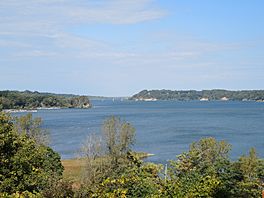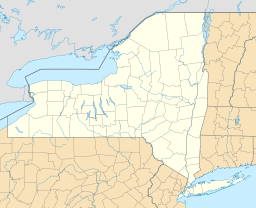Irondequoit Bay facts for kids
Quick facts for kids Irondequoit Bay |
|
|---|---|

View from Lucien Morin Park in Penfield, New York
|
|
| Coordinates | 43°12′18″N 77°31′52″W / 43.205°N 77.531°W |
| Type | Bay |
| Native name | O-nyiu-da-on-da-gwat Error {{native name checker}}: parameter value is malformed (help) |
| Etymology | "It turns out"/"It goes aside" |
| Primary inflows | Densmore Creek, Irondequoit Creek |
| Primary outflows | Lake Ontario |
| Managing agency | New York State Department of Environmental Conservation |
| Max. length | 4 miles (6.4 km) |
| Max. width | 0.5 miles (0.80 km) |
| Surface area | 1,660 acres (670 ha) |
| Max. depth | 73 feet (22 m) |
| Shore length1 | 17.7 miles (28.5 km) |
| Surface elevation | 250 feet (76 m) |
| Islands | Fish Island, Held Island, Snider Island |
| Settlements | Irondequoit, Penfield, Webster |
| 1 Shore length is not a well-defined measure. | |
Irondequoit Bay is a large body of water located in northeastern Monroe County, New York. This bay is about 0.5 miles (0.8 km) wide and 4 miles (6.4 km) long. It gets its water from Irondequoit Creek in the south. The bay then flows into Lake Ontario at its northern end.
The surface of Irondequoit Bay is usually about 245 feet (75 meters) above sea level. Its deepest spot is about 80 feet (24 meters) deep. This deep area is a short distance north of the Irondequoit Bay Bridge. This bridge carries the six-lane New York State Route 104 over the bay.
The middle of the bay forms the eastern border for the town of Irondequoit. It also forms the western border for the towns of Penfield and Webster. The border between Irondequoit and Penfield continues along the middle of Irondequoit Creek. This is south of the New York State Route 404 float bridge.
How Irondequoit Bay Was Formed
Over the last million years, the Rochester area was covered by ice four times. These ice ages, called glaciers, greatly changed the land. The most recent glacier left its marks about 100,000 years ago. It pressed down on the earth by as much as 2,500 feet (760 meters).
About 12,000 years ago, big changes happened in the area. The paths of rivers like the Genesee River were moved. The earth also started to bounce back up after the heavy glaciers melted. This happened faster in Canada than in New York. Because of this, water from Lake Ontario flowed over New York, which was at a lower elevation. During this time, the original path of the Genesee River was flooded. This flooding created Irondequoit Bay as we know it today.
A Look at the Bay's History
On a French map from 1688, called "Le Lac Ontario," Irondequoit Bay was shown. It was called the "swamp of the Senecas." The Seneca people are a Native American group. Before the 1840s, the bay was known by a different name: "Teoronto Bay."
Parks Around the Bay
Seven parks are located next to Irondequoit Bay. These parks offer places for people to enjoy the bay and its surroundings.
- Devil's Cove Park, Webster
- Ellison Park, Penfield
- Irondequoit Bay Marine Park, Irondequoit
- Abraham Lincoln Park (formerly Irondequoit Bay Park East), Penfield
- Irondequoit Bay Park West, Irondequoit
- LaSalle's Landing Park, Penfield
- Sandbar Park, Webster


